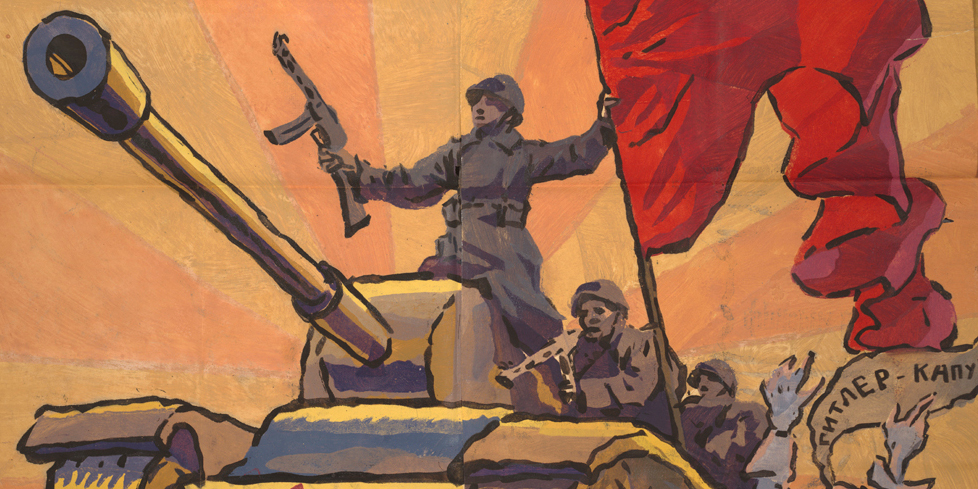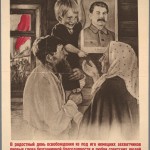
April 14, 2013, by Stephen Mumford
Propaganda and Art
What are we to make of art that is put to some morally dubious purpose? Can we still appreciate it as art or has it become tainted by its use? Politicians are acutely aware of the stirring and motivating power of art and thus it is natural that they put it to use in propaganda, especially wartime propaganda. Is it right for us still to appreciate the artistic merit of something utilised so politically? And does that depend on whether we agree with the politics?
I encountered these questions recently when viewing a new collection of Russian war posters at Nottingham: Windows on War: Soviet War Posters, 1943-45. These posters seemed beautifully designed with vivid colours and dynamic layouts. They all had an original artist but had been subsequently mass-produced through stencilling for wide distribution. The posters were large, folded and now fragile but were being preserved, restored and then digitised for future use. All those with interests in history, politics, art, Russian studies and digital humanities will find them fascinating. But as a philosopher it was the tension between aesthetics and ethics that struck me most.
 It is easy to enjoy the superficial appearances of the images. They are pleasing to the eye and one can be swept along by the sentiments conveyed. But there is always a lurking uneasiness. The posters are, among other purposes, in praise of Stalin. Nazis are at times shown to be sub-human. Hitler is caricatured as a pig. Now of course no right person is going to defend the Nazis in World War II but we know that all sides committed atrocities in this conflict. The feeling of uneasiness is nevertheless in the knowledge that propagandists wanted me to enjoy these posters and thereby gain my favourable sentiments. They wanted the viewer to take inspiration and redouble their efforts for the Red Army and Joseph Stalin.
It is easy to enjoy the superficial appearances of the images. They are pleasing to the eye and one can be swept along by the sentiments conveyed. But there is always a lurking uneasiness. The posters are, among other purposes, in praise of Stalin. Nazis are at times shown to be sub-human. Hitler is caricatured as a pig. Now of course no right person is going to defend the Nazis in World War II but we know that all sides committed atrocities in this conflict. The feeling of uneasiness is nevertheless in the knowledge that propagandists wanted me to enjoy these posters and thereby gain my favourable sentiments. They wanted the viewer to take inspiration and redouble their efforts for the Red Army and Joseph Stalin.
The question of whether an ethical flaw produces also an aesthetic defect comes into the foreground. On the other side, Leni Riefenstahl was producing seemingly beautiful cinematography in praise of Hitler. It was a war of art. But just as I have viewed and enjoyed Riefenstahl’s films, I can discern an artistic content in these Russian posters: something that lies behind the propaganda and can be appreciated in its own terms.
The online exhibition of Soviet war posters can be found here: http://windowsonwar.nottingham.ac.uk/

This raises a really interesting point. When the posters were initially exhibited in the Weston Gallery in 2009, we were somewhat nervous about how they would be received by the Lakeside Arts Centre audience. The visitor book showed that while many enjoyed the striking colours and images, others had a visceral reaction, with one visitor reminding us that there’s “not much to celebrate here”.
[…] state fears free thought. It will try to control of the arts and deliver its own message, as Stalin’s war posters did. But Orwell’s pessimism could be resisted, as he knew himself. There was hope for those […]